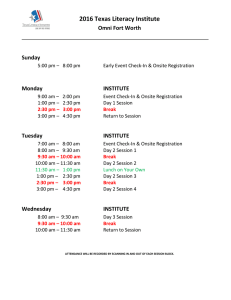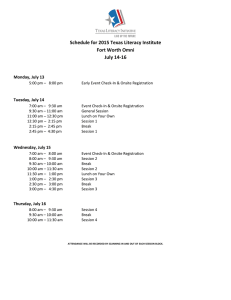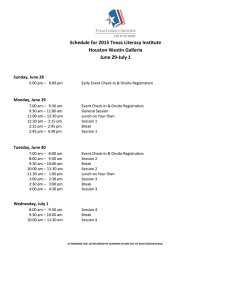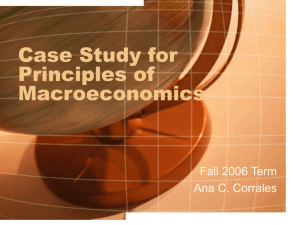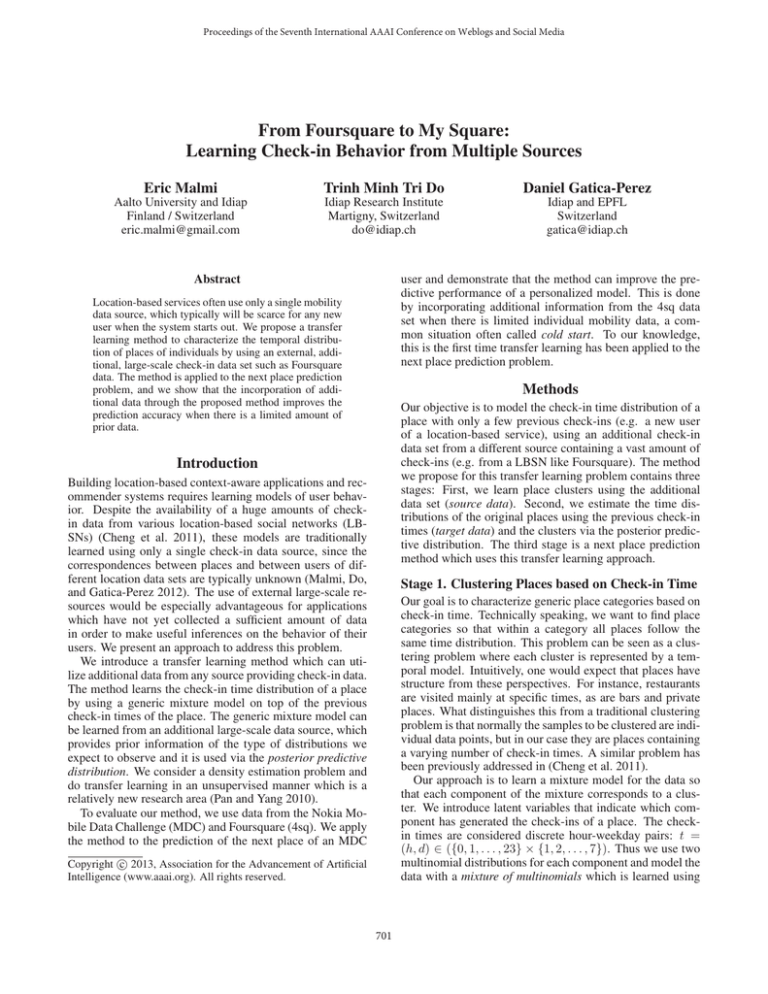
Proceedings of the Seventh International AAAI Conference on Weblogs and Social Media
From Foursquare to My Square:
Learning Check-in Behavior from Multiple Sources
Eric Malmi
Trinh Minh Tri Do
Daniel Gatica-Perez
Aalto University and Idiap
Finland / Switzerland
eric.malmi@gmail.com
Idiap Research Institute
Martigny, Switzerland
do@idiap.ch
Idiap and EPFL
Switzerland
gatica@idiap.ch
user and demonstrate that the method can improve the predictive performance of a personalized model. This is done
by incorporating additional information from the 4sq data
set when there is limited individual mobility data, a common situation often called cold start. To our knowledge,
this is the first time transfer learning has been applied to the
next place prediction problem.
Abstract
Location-based services often use only a single mobility
data source, which typically will be scarce for any new
user when the system starts out. We propose a transfer
learning method to characterize the temporal distribution of places of individuals by using an external, additional, large-scale check-in data set such as Foursquare
data. The method is applied to the next place prediction
problem, and we show that the incorporation of additional data through the proposed method improves the
prediction accuracy when there is a limited amount of
prior data.
Methods
Our objective is to model the check-in time distribution of a
place with only a few previous check-ins (e.g. a new user
of a location-based service), using an additional check-in
data set from a different source containing a vast amount of
check-ins (e.g. from a LBSN like Foursquare). The method
we propose for this transfer learning problem contains three
stages: First, we learn place clusters using the additional
data set (source data). Second, we estimate the time distributions of the original places using the previous check-in
times (target data) and the clusters via the posterior predictive distribution. The third stage is a next place prediction
method which uses this transfer learning approach.
Introduction
Building location-based context-aware applications and recommender systems requires learning models of user behavior. Despite the availability of a huge amounts of checkin data from various location-based social networks (LBSNs) (Cheng et al. 2011), these models are traditionally
learned using only a single check-in data source, since the
correspondences between places and between users of different location data sets are typically unknown (Malmi, Do,
and Gatica-Perez 2012). The use of external large-scale resources would be especially advantageous for applications
which have not yet collected a sufficient amount of data
in order to make useful inferences on the behavior of their
users. We present an approach to address this problem.
We introduce a transfer learning method which can utilize additional data from any source providing check-in data.
The method learns the check-in time distribution of a place
by using a generic mixture model on top of the previous
check-in times of the place. The generic mixture model can
be learned from an additional large-scale data source, which
provides prior information of the type of distributions we
expect to observe and it is used via the posterior predictive
distribution. We consider a density estimation problem and
do transfer learning in an unsupervised manner which is a
relatively new research area (Pan and Yang 2010).
To evaluate our method, we use data from the Nokia Mobile Data Challenge (MDC) and Foursquare (4sq). We apply
the method to the prediction of the next place of an MDC
Stage 1. Clustering Places based on Check-in Time
Our goal is to characterize generic place categories based on
check-in time. Technically speaking, we want to find place
categories so that within a category all places follow the
same time distribution. This problem can be seen as a clustering problem where each cluster is represented by a temporal model. Intuitively, one would expect that places have
structure from these perspectives. For instance, restaurants
are visited mainly at specific times, as are bars and private
places. What distinguishes this from a traditional clustering
problem is that normally the samples to be clustered are individual data points, but in our case they are places containing
a varying number of check-in times. A similar problem has
been previously addressed in (Cheng et al. 2011).
Our approach is to learn a mixture model for the data so
that each component of the mixture corresponds to a cluster. We introduce latent variables that indicate which component has generated the check-ins of a place. The checkin times are considered discrete hour-weekday pairs: t =
(h, d) ∈ ({0, 1, . . . , 23} × {1, 2, . . . , 7}). Thus we use two
multinomial distributions for each component and model the
data with a mixture of multinomials which is learned using
c 2013, Association for the Advancement of Artificial
Copyright Intelligence (www.aaai.org). All rights reserved.
701
Raw counts
the Expectation-Maximization algorithm (Rigouste, Cappé,
and Yvon 2007). Furthermore, we assume that the hour and
weekday are independent, i.e., p(h, d) = p(h)p(d). The resulting density function for a single check-in time is
πc p(h | θ c )p(d | ϕc ),
(1)
p(t | θ, ϕ) =
2
0
0
≈
0
0
3
6
9 12 15 18 21 24
0
0
3
6
9 12 15 18 21 24
(3)
Stage 3. Next Place Prediction
In next place prediction, the task is to find where a user will
go given his mobility history (Laurila et al. 2012). Formally,
let {(X1 , T1 ), ...(Xn , Tn )} be the check-in history of a given
user where Xi represents the place of the ith visit and Ti
represents the temporal information of the visit. We want to
predict the most probable value x of random variable Xn+1
and, in our problem setting, we assume that we are given the
current place Xn = x and the end time of the current visit
Tne = t . Thus the task can be formulated as follows
xpred = argmax {p(Xn+1 = x | Xn = x , Tne = t )} . (4)
p(t̃ | z = c, t, θ, ϕ) p(z = c | t, θ, ϕ)
x
We shall denote the probability simply by p(xn+1 | xn , ten ),
which is estimated based on the mobility history.
Typically, the amount of data is insufficient to estimate the
probability directly. We combine the approaches presented
recently by (Etter, Kafsi, and Kazemi 2012) and (Gao, Tang,
and Liu 2012), and obtain the following model
p(t̃ | z = c, θ, ϕ) p(z = c | t, θ, ϕ)
p(t̃ | z = c, θ, ϕ) p(z = c | θ, ϕ) p(t | z = c, θ, ϕ)
p(h̃ | θ c )p(d˜ | ϕc )πc p(h | θ c )p(d | ϕc ).
9 12 15 18 21 24
where α is called transfer coefficient.
c=1
C
6
α p(t̃ | θ , ϕ ) + (1 − α) p(t̃ | t, θ, ϕ),
c=1
C
3
p(t̃ | t, θ , ϕ , θ, ϕ) =
c=1
∝
0.1
0.05
place has been visited many times in the past, a simple multinomial estimate might be accurate. The resulting model is
the following
We present three models for estimating the time distribution
of a place, namely Multinomial, Posterior Predictive Distribution (PPD), and Combined. The first model does the estimation based on the previous check-in times of the place, i.e.
the target data, by calculating check-in counts. In addition,
we apply Laplace smoothing to the multinomial distribution
so that all times have a non-zero probability. This model
does not use the source data set.
In the latter two models, we use a mixture of multinomials learned from the source data. We assume that the underlying place categories are the same in the source and the
target data and introduce a latent variable z which indicates
the component (= category) that has generated the previous
check-in times t. In the second model, the PPD of the next
check-in time t̃ takes the form
≈
0.1
0.05
Figure 1: Raw check-in hour counts (left), the corresponding Multinomial model which includes Laplace smoothing
(middle) and the corresponding PPD model which uses a
mixture model learned from the source data (right).
Stage 2. Inferring Time Distributions Across Data
Sets
C
PPD
0.15
6
where distributions p are multinomial, θ c and ϕc are the
multinomial parameters of the hour and day distribution of
mixture component c, respectively, and πc is the mixing proportion of component c.
C
0.15
4
c
p(t̃ | t, θ, ϕ) =
Multinomial + smoothing
8
p(xn+1 | xn , ten ) ≈
s
p(Δtn | Δxn )p(tn+1 | xn+1 ) , (5)
p(xn+1 | xn )
(2)
c=1
tsn+1
Note that we have approximated p(z = c | θ, ϕ) = p(z =
c) ≈ πc which does not strictly hold since the relative proportions of different categories are not necessarily the same
in the two data sets. To give an idea of what the PPD does in
practice, we show, in Fig. 1, an example of the Multinomial
model and the corresponding PPD model learned from the
data described in the next section. We can see that the PPD
smooths the multinomial distribution, but on the other hand,
the effect of Laplace smoothing disappears.
Finally, in the Combined model, we take a linear combination of the Multinomial model (θ , ϕ ) and the PPD model
(Eq. 2). This is motivated by the fact that the target and
the source data do not follow exactly the same distribution
in practice (one of the basic assumptions in several transfer
learning techniques) (Pan and Yang 2010) and if the original
where p(xn+1 | xn ) is a Markov model, p(Δtn | Δxn ) is a
travel time distribution between the end time of the current
visit (ten ) and the start time (check-in time) of the next visit
(tsn+1 ). Due to the summation, the time distribution p(tsn+1 |
xn+1 ) does not depend on the end time of the visit, which
allows us to estimate it using the PPD model and a source
data set that only contains the check-in times.
Data
We use the two data sets studied previously in (Malmi, Do,
and Gatica-Perez 2012). The target data set comes from the
Nokia Mobile Data Challenge (MDC) (Laurila et al. 2012).
The MDC data set contains daily life data from 80 users
and about 16 months in Switzerland. The users were given
702
0.2
0.2
0.2
0.1
0.1
0.1
θ
0
0 3 6 9 12 15 18 21 24
Hour of the day
0
0 3 6 9 12 15 18 21 24
Hour of the day
0
0 3 6 9 12 15 18 21 24
Hour of the day
0.3
0.3
0.3
ϕ 0.2
0.2
0.2
0.1
0
0.1
0
Mo Tu We Th Fr Sa Su
Day of the week
0.1
Mo Tu We Th Fr Sa Su
Day of the week
0
Mo Tu We Th Fr Sa Su
Day of the week
Figure 3: Daily and weekly check-in time distributions of
the three components with the highest mixing coefficients in
the 4sq mixture model.
The transfer coefficient α from Eq. 3 is learned using Set
B as training data and Set C as validation data. The highest
prediction accuracy on Set C is obtained when α = 0.6. The
travel time distribution p(Δtn | Δxn ) is learned using Set
A in whole. Travel time Δtn is divided into bins of one
hour, which is the time resolution of our model, and travel
distance Δxn into bins of five kilometers.
Results
We first optimize the parameters of the models, and then
evaluate the performance of the transfer learning applied to
the time distribution inference and to the next place prediction problem. To calculate the results, the MDC data set is
divided into training data (Set B), validation data (Set C),
and test data (Set T) as shown in Fig. 2.
Evaluation of Time Distribution Estimation
To evaluate how accurately we can predict the future checkin times of a place by using only the MDC data or by using
the transfer learning approach, we divide Set A as follows:
the last 30 check-ins of each place in Set A are used as test
data and Np preceding check-ins are used for training while
varying Np . The higher the log likelihood obtained for the
unseen test data, the better the model.
Figure 4 shows log likelihood as a function of Np . We
can see that the PPD model performs clearly better than
the Multinomial model when there is little data for a place.
However, only about five visits seem to be sufficient in PPD
to estimate to which clusters the place belongs to and thus
the likelihood converges in relatively few steps. Nevertheless, by combining the two models according to Eq. 3, we
observe a better performance than either of the individual
methods when Np is around 35 and elsewhere a better or
similar performance compared to the Multinomial model.
3
2
1
Table 1: Key statistics of the MDC and 4sq data sets.
#places #users #visits First visit
Last visit
MDC 7281
80 51607 30 Sep 2009 4 Feb 2011
4sq 17482 302 40629 19 Dec 2011 21 Jun 2012
Component 3, π = 0.036
Component 2, π = 0.048
Component 1, π = 0.049
a smartphone which used a variety of sensor data to infer instantaneous locations and visited places of the users.
The place detection algorithm is described in (Montoliu and
Gatica-Perez 2010).
The source data set comes from Foursquare (4sq), which
is a highly popular LBSN, and it has been collected through
the Twitter API accepting only check-ins from Switzerland.
Our aim is to predict the check-in behavior of the MDC users
by learning additional temporal characteristics of the MDC
places using the 4sq data. While the MDC visits contain
both a start and an end time, the 4sq check-ins contain only
the check-in time. In this study, we do not consider, e.g.,
the location but only the check-in times of a place. Table 1
summarizes the key statistics of the two data sets.
Figure 2: The check-in sequences of the MDC users are divided into different sets used for training (Set B), validation
(Set C), and testing (Set T). Set A denotes B ∪ C.
Estimation of Model Parameters
Log likelihood
We learn the multinomial mixture model from the 4sq data
set to cluster MDC places. Using k-fold cross-validation, we
find 80 to be the optimal number of mixture components.
Fig. 3 shows the three components with the highest mixing
coefficients. We observe that different components capture
different kind of places. Component 2 contains workplaces
as it is mostly visited during weekdays in the morning (when
people arrive to work) and in the afternoon (when they return from lunch), whereas component 3 contains nightlife
spots and homes where people arrive to in the evening. Note
that in our approach, we do not assume that clusters correspond exactly to 4sq venue categories, which are semantic
categories rather than data-driven components.
−40
−50
Multinomial
PPD
Combined
−60
−70
0
20
40
60
Np
80
100
Figure 4: Log likelihood as a function of the number of preceding training visits per place (Np ) for the three methods.
703
Evaluation of Next Place Prediction Task
cent absolute improvement is obtained with transfer learning
when Nu is around 20.
Finally, we assess if using transfer learning with data from
4sq helps to predict the mobility patterns of the MDC users.
The prediction test accuracies are calculated based on Set
T (see Fig. 2) by taking an average of each user’s accuracy
weighted by the number of test samples the user has. We
vary the number of training place transitions per user (Nu )
in Set A, starting from the most recent samples, so that we
see how the amount of training data affects the performance
of transfer learning. Test samples always start right after the
last training sample and the test data set (Set T) is thus kept
fixed. The only exception is that the users who do not have
enough training data are not taken into account.
The next place prediction results are shown in Fig. 5 (topleft). The accuracy naturally increases when Nu increases.
However, there are also some drops in the accuracy since
the set of users on whom the accuracy is calculated might
vary as the users with too few training samples are ignored.
When the number of training samples is 450, there are only
ten MDC users with enough data. The relative performance
of the methods, shown in Fig. 5 (top-right), shows that a 2
percent absolute improvement in prediction accuracy is obtained with transfer learning when Nu is around 20, which
corresponds to 9 days of data collection when averaged over
all users. One-tailed paired t-test shows that the improvement is statistically significant at the 0.01 level. After about
Conclusions
For a mobility prediction task, we presented a transfer learning method to learn the check-in time distributions of places,
using the advantages of additional large-scale check-in data
available in LBSNs like Foursquare, in a complementary
manner. The additional data set can originate from any
check-in data source and it can also be a combination of several data sets. We showed that the proposed method (Combined) outperforms the traditional method (Multinomial) in
terms of likelihood. Furthermore, we applied our method
to the next place prediction problem, and showed that it improves the predictions when the users have up to 45 days of
data. The method thus helps tackling the cold start problem.
Furthermore, new LBSNs or games could use the method
to improve their predictive analytics and recommender systems.
Acknowledgments
This research was funded by the LS-CONTEXT project
(Nokia Research Lausanne) and the HAI project (Swiss National Science Foundation).
References
Cheng, Z.; Caverlee, J.; Kamath, K. Y.; and Lee, K. 2011.
Toward traffic-driven location-based web search. In Proc.
ACM Int. Conf. on Information and Knowledge Management.
Etter, V.; Kafsi, M.; and Kazemi, E. 2012. Been there, done
that: What your mobility traces reveal about your behavior.
In Proc. Mobile Data Challenge Workshop.
Gao, H.; Tang, J.; and Liu, H. 2012. Mobile location prediction in spatio-temporal context. In Proc. Mobile Data
Challenge Workshop.
Laurila, J.; Gatica-Perez, D.; Aad, I.; Blom, J.; Bornet, O.;
Do, T.-M.-T.; Dousse, O.; Eberle, J.; and Miettinen, M.
2012. The mobile data challenge: Big data for mobile computing research. In Proc. Mobile Data Challenge Workshop.
Malmi, E.; Do, T.; and Gatica-Perez, D. 2012. Checking in
or checked in: comparing large-scale manual and automatic
location disclosure patterns. In Proc. Int. Conf. on Mobile
and Ubiquitous Multimedia.
Montoliu, R., and Gatica-Perez, D. 2010. Discovering human places of interest from multimodal mobile phone data.
In Proc. Int. Conf. on Mobile and Ubiquitous Multimedia.
Pan, S., and Yang, Q. 2010. A survey on transfer learning. IEEE Transactions on Knowledge and Data Engineering 22(10):1345–1359.
Rigouste, L.; Cappé, O.; and Yvon, F. 2007. Inference and
evaluation of the multinomial mixture model for text clustering. Information processing & management 43(5):1260–
1280.
50
40
MDC only
Combined (α=0.6)
Accuracy (%)
100
200
300
400
#train samples per user
0−order Markov Model
55
50
45
40
35
MDC only
Combined (α=0.6)
100
200
300
400
#train samples per user
Percentage points
60
2
1
MDC only
Combined (α=0.6)
0
−1
0
Percentage points
Accuracy (%)
Difference with the MDC only method
100
200
300
400
#train samples per user
Difference with the MDC only method
4
2
MDC only
Combined (α=0.6)
0
0
100
200
300
400
#train samples per user
Figure 5: Top-left: next place prediction accuracy for the
Multinomial model, which is the baseline method, and the
Combined model, which uses transfer learning. Top-right:
accuracy differences between the two methods. Bottom:
performance when the Markov model part in Eq. 5 has been
replaced by a 0-order Markov model.
100 training samples, corresponding to 45 days, transfer
learning no longer improves the prediction accuracy, which
suggests that the personalized data is better on its own.
Transfer learning is only applied to the time distributions but not to the Markov model part of Eq. 5, which
mainly dominates the predictions. To suppress the impact of
the Markov model and understand the sole effect of transfer learning, we calculate the prediction accuracies using
a 0-order Markov model instead of the standard 1st-order
Markov model. The results are shown on the bottom of
Fig. 5. Now we can see the difference more clearly: a 4 per-
704

